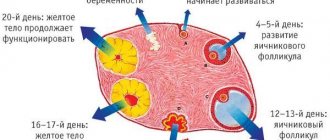Normal menstrual cycle
The duration of menstruation varies among women. A normal cycle ranges from 27 to 32 days (its average duration). Typically, your period begins within 5–7 days after ovulation completes. This is the norm for a healthy woman.
It is impossible to determine exactly how many days menstruation lasts, since it depends on many factors, for example, weather conditions or psychological state. For mature women, menstruation lasts approximately 7 days. But they may end earlier than expected.
4–7 days is the duration of critical days, which is the norm. A woman should have bleeding every month, the presence of which indicates her reproductive health.
Under the influence of certain factors, a malfunction may occur in the monthly cycle, as a result of which critical days may begin earlier or later than expected. If the delay is 2–4 days, then there is no reason to panic, since such a deviation is acceptable. When delay occurs regularly, you need to undergo a medical examination. A shift in the monthly cycle by more than 5 days indicates the development of gynecological pathology.
During normal menstruation, the bloody discharge should not contain any clots or mucus. Also, they should not be abundant. The presence of pathological processes in the body is indicated by short menstruation, the duration of which is less than 3 days. During this short period, the uterine endometrium will not have time to completely separate and renew itself. As a result, the body will not cleanse itself and prepare for the possible fertilization of the egg.
Bloody discharge during menstruation should not smell unpleasant. If on the third day their smell and quantity makes you anxious, then it is recommended to visit a gynecologist.
Menopause: when menstruation ends forever
But, let’s figure out what the essence of this terrible “monster” called menopause is. Maybe “the devil is not as scary as he is painted”?
When to expect menopause
There are cases in history where menstruation continued even at the age of 60, but this is more of a unique case than a regular one. It is clear that at the age of 55 the cycle becomes irregular, scarce, and conceiving a child becomes almost impossible.
For some female representatives, menopause begins at the age of 40; more precisely, every eighth woman on the planet has early menopause.
In nature, there are three periods of menopause:
- Premenopause (premenopausal). Comes after 40 years. Menstruation occurs during the premenopausal period, but for the most part without the formation of an egg. It turns out that they no longer seem to have their periods fully, because they pass without ovulation. The general hormonal balance is disrupted and there is a high probability of gaining extra pounds (5-10 kg) during this period. The changes also affect the condition of the skin: the number of wrinkles increases, the elasticity of the epidermis is lost. A woman's sexual activity decreases. The premenopausal period lasts from 1 to 10 years.
- The second period is called menopause . The follicles that remain in the ovaries change. The periods themselves change. The volume of discharge decreases, shortens, or, conversely, the interval between cycles lengthens. Critical days become irregular, which is normal and does not require treatment. That is, the number of follicles in the ovaries is reduced, which leads to a decrease in estrogen production. This means that progesterone also decreases. As a result, the follicles run out completely, and menstruation stops forever. This period is characterized by an exacerbation of chronic diseases, an increase in excess weight, and in some cases, obesity. The risk of cardiovascular diseases and the development of diabetes mellitus increases. The menopause period lasts from 1 year or more.
- And the last, third, period is called postmenopause . Their onset occurs one year after the end of the last menstruation. The woman's general condition returns to normal. Hormonal levels are balanced, health improves, and metabolic processes in the body are restored. Any female representative can judge the cessation of menopause by the increased level of the hormone FSH, which can be detected in the blood or urine.
All these processes are only individual in nature.
Some women will not notice any special changes in the body, while others, on the contrary, will feel all the changes. Basically, heredity plays a big role here. So, if a woman wants to know what awaits her during menopause, let her ask the older generation of women.
Of course, if there were no external interventions, for example, ovarian surgery, chemotherapy, etc. And also, the woman does not abuse alcohol and smoking.
Symptoms of menopause
Any woman, by her nature, is unique, therefore the “bouquet” of first signs will be different and unique.
Sometimes during reproductive age a woman seems to feel the symptoms of approaching menopause. But this could be amenorrhea - a menstrual disorder in which menstruation does not occur. In rare cases, menopause occurs at 30–35 years of age, but this is not a pattern, but an exception to the rule.
All symptoms of menopause are divided into:
- Early (premenopausal phase);
- Average (menopause);
- And, late (postmenopausal phase).
We will try to consider the most complete list of possible first signs of menopause:
1. Early:
- The most common symptom of the oncoming menopause is a disruption of the menstrual cycle. They can go whenever they want. They can be abundant or scanty. The interval between menstruation increases, and over time, the critical days end forever.
- Tides. This is a sudden increase in temperature in the upper parts of the body: face, neck, chest.
- Sweating. Occurs as a consequence of hot flashes. May be profuse, in the form of perspiration on the body.
- Sudden chills that are not natural phenomena.
- Insomnia.
- Drowsiness, lethargy, weakness throughout the day - all this occurs due to insomnia. Often such conditions can lead a woman to depression.
- The early stage also affects pressure changes, and the heart rate may increase.
- Due to poor health and lack of sleep, a woman becomes irritable and aggressive.
- Sexual desire decreases or disappears.
- The woman becomes dissatisfied with her life, headaches and migraines appear. As a result, all of the above often fails.
2. The middle stage implies the following signs:
- The internal mucous membranes reduce the abundance of secretions, which causes dryness and burning of the genitals. This all happens due to low amounts of progesterone and estrogen.
- Pain occurs during sex because the amount of lubrication in the vagina decreases.
- Wrinkles, dry skin, loss of elasticity, brittle nails, hair loss - this is the aging of the body.
- Frequent urge to go to the toilet, urinary incontinence as a result of hormonal imbalance and low immunity.
3. Late period:
- Osteoporosis is a bone disease.
- Disease of the heart and blood vessels.
- Vein disease.
- Loss of the ability to remember new knowledge and skills. This applies to older (senile) age.
If a woman experiences several of the above symptoms and is over 40 years old, it is recommended not to make a diagnosis on her own, but to consult a specialist. A gynecologist will help you cope with your body as best as possible.
How to relieve menopause
- Treatment with hormones . During menopause, a woman's levels of progesterone and estrogen sharply decrease, which leads to health problems (osteoporosis, vascular blockage, stroke, etc.). By taking hormones, progesterone and estrogen are balanced. As a result, hot flashes and sweating decrease, insomnia disappears, and the woman’s general condition improves significantly. But recently it was discovered that when treated with hormones, the risk of cancer increases sharply. Therefore, it is recommended to look for other ways to treat menopause.
- Dietary supplements or phytohormones . They also replenish the body with essential estrogen. True, there are contraindications: tumors and people whose metabolism is slow, because the drugs cause excess weight.
- Homeopathy . Such remedies are used very successfully for a long time and successfully relieve the signs of menopause. But that’s not all, you need to reconsider your lifestyle and adjust some nuances that will help you get through this difficult period with ease:
- Make morning exercise your friend. A little warm-up, swinging your arms and legs will improve your well-being, lift your spirits and relieve headaches.
- to walk outdoors every day , especially before bed. This will help you understand your inner feelings and work up an appetite for the night. You can include your relatives in the walks, and this will further strengthen the family.
- Don't forget to pamper yourself with your favorite active activities . For example, dancing, yoga, fitness, sports. These methods will perfectly help you relax and satisfy your mental and physical well-being.
- Give up bad habits as much as possible . Drink less alcohol, eat right, quit smoking, drink more clean water. All this is a guarantee of health.
- It is important not to indulge in poor health with sweets and carbohydrates. Extra pounds don't make anyone look better, and you won't be healthier from what you eat.
- Try to sleep at least 8 hours a day . Healthy sleep is the key to a good mood.
- Avoid stressful situations , be less nervous and believe only in the good, because it has long been known that thoughts are material. And with an integrated approach to menopause, you can avoid many negative factors, improve your condition as much as possible, and you won’t notice how menopause ends.
How many days does your period last?
If you know how many days your period should last, you can notice the deviation in a timely manner. In a healthy woman, the duration of menstruation is from 4 to 7 days. Their “normality” can be judged by the nature of the discharge. If the color of menstruation is dark red or burgundy, this means that there are no problems with the separation of the uterine endometrium.
Light menstrual blood with clots of mucus is a reason to sound the alarm. There is probably a pathological process occurring in the body.
On average, the discharge ends on the 6th day after the start. That is, normal periods last approximately 5–6 days. But since each organism is unique, deviations are possible. There is no clearly established time regulating the duration of critical days.
Regardless of the duration, menstruation is accompanied by an uncomfortable sensation that occurs in the lower abdomen, weakness, nausea and other unpleasant symptoms. Severe pain during menstruation is called dysmenorrhea. If the discomfort these days is unbearable, it makes sense to take pain medication.
What can color say?
The color of monthly discharge can serve as a definite indicator for a woman of the health of the reproductive system. Normally, the discharge should be a rich dark red color. There should be no foreign pungent odor or pus.
Changes in the nature of the discharge may indicate a hormonal imbalance or even the appearance of neoplasms in the uterus, ovaries, or the development of pathology.
Scarlet blood
If on the second day the blood during menstruation is scarlet in color, then we can say that this is an ideal indicator. The woman’s reproductive system works correctly, there are no deviations. Such secretions have a subtle smell of iron.
The preservation of this color on the third day of menstruation should alert you, especially when the discharge is scanty. Such blood can be released in a young girl during the start of her cycle, then this is considered the norm, as well as during the onset of menopause. In a young woman of reproductive age, the scarlet color of the blood, which persists throughout menstruation, indicates possible problems. A gynecological examination will clarify the picture. It may be:
- Pregnancy with developmental pathologies.
- Polyp in the uterus.
- Recent abortion.
- Malignant formation of the pelvic organs.
- Infectious disease.
What determines the duration of menstruation?
We found out that the average duration of menstruation is 4–7 days. Usually healthy girls rarely encounter any deviations from the norm. But under the influence of certain factors, failures are possible. So, the duration of menstruation in women depends on:
- from heredity. If women in a particular family are characterized by a 10-day duration of critical days, then this is not a pathology ;
- functioning of the ovaries. Some diseases of the genital organs provoke their dysfunction. This negatively affects the duration of the cycle. If, due to impaired functioning of the ovaries, the mucous membrane of the genital organs has been damaged, menstruation will be long and painful;
- the presence of infectious diseases and inflammatory processes. Inflammation of the genital organs provokes heavy bleeding and an increase in the duration of menstruation;
- functioning of the endocrine system. If there is a deviation in the functioning of the pancreas or thyroid gland, then a hormonal imbalance will occur in the body. This will entail a shift in the monthly cycle and, as a result, a delay in menstruation.
Reasons for short periods
Scanty periods are an indicator of a disrupted cycle. If menstruation begins several days before the expected due date, this is an alarming symptom. You should also be wary of such a problem as short periods, the duration of which is 1–2 days. This deviation does not appear without a reason. It is provoked by the following factors:
- Ovarian dysfunction.
- Impaired functioning of the thyroid gland.
- Diseases of the reproductive organs.
- Hormonal disorders.
- Infection of the genital tract.
In gynecology, scanty periods are called hypomenorrhea. Blood loss during short menstruation is low, not exceeding 50 ml per day. This indicates a violation of reproductive function.
Causes of long periods
Normal critical days last from 3 to 7 days. The duration of menstruation increases if pathological processes occur in the female body.
Factors that provoke an increase in the duration of menstruation:
- Diseases of the genital tract or uterus. For example, prolonged periods provoke some forms of endometriosis.
- Hormonal changes in the body.
- Ovarian dysfunction.
- Diseases of the endocrine system.
- Long term use of antibiotics and hormonal drugs.
Prolonged discharge, when the monthly cycle fails, is accompanied by severe pain in the lower abdomen, as well as nausea and dizziness.
How is the first menstruation, and how to prepare the child?
The first signs of menstruation in girls are spotting . They can be moderate or very scanty. During the first menstruation, about 50–150 ml of blood leaves the body (depending on the individual characteristics of the girl and hereditary factors). On the very first day, a small amount of menstrual blood is lost. The most abundant discharge is observed on the second day. Then their volume gradually decreases. The duration of menstruation can range from 3 to 7 days.
The first time a girl's period may be accompanied by weakness and discomfort in the lower abdomen . They can also be observed during the next menstruation. These symptoms occur in most adult women, so there is no need to worry about them.
Menstruation has a characteristic smell. It is explained by the fact that during menstruation the mucous glands of the vulva actively function, producing secretions.
The first spotting and mild nagging pain can frighten the child. The mother’s task is to explain to her girl that menstruation is a normal physiological process that occurs in the body of every girl and adult woman. The conversation should be friendly, not didactic.
The mother should tell her daughter:
- About the menstrual cycle. Critical days occur every month. It is imperative to say how long girls' periods last. It should also be noted that the average duration of the menstrual cycle is 28 days, but during the first two years it may fluctuate.
- The need to follow hygiene rules. Blood is a very favorable environment for the growth and reproduction of microorganisms. They can lead to the development of serious inflammatory diseases of the genitourinary system.
- About the risks of sexual relations. With the onset of menstruation, every girl enters childbearing age, and intimate relationships with the opposite sex can lead to pregnancy, which is extremely undesirable at this age. Childbirth can be harmful to both the new mother and her baby. That is why a girl should know about what promiscuity and unprotected sex can lead to.
Features of the menstrual cycle
In teenage girls, the menstrual cycle (the period from the first day of the previous menstruation to the first day of the next menstruation) is 21–35 days. However, during the first two years, not everyone experiences it regularly . For some it fluctuates constantly. For example, one menstrual cycle may be 25 days and the next 32 days. This is normal. It does not indicate that the girl has any pathology. If you have any suspicions, you can visit a doctor. The specialist will tell you exactly whether this is normal or an illness.
It is worth noting that the intervals between menstruation can range from one and a half months to six months . Don't worry if your period doesn't come on time. At a young age, menstrual function is not yet fully formed. This is why some girls experience long breaks. If your period does not come after several months, then you need to seek help from a doctor. A long pause between the first and second periods in girls may indicate a serious malfunction in the young body.
With the onset of her first menstruation, your daughter should be taught to keep a calendar in which she can mark when her periods began and ended. This information may not be useful in the first 1–2 years from the start of your period, because at this time the menstrual cycle has not yet fully established itself. But then the calendar will come in handy when consulting with a specialist if the cycle remains irregular. Too short or long periods, a small or large gap between menstruation may be a sign of some disease.
Hygiene and diet during menstruation
Hygiene is an important issue that mothers should cover when teaching their daughters about menstruation. During menstruation, all girls and adult women use pads and tampons. For girls, pads are the most preferred. Tampons interfere with the natural flow of blood. Gaskets are much more convenient to use. It is best for girls to buy these intimate hygiene products with a cotton layer. Pads with a mesh coating (“plastic” layer) are less hygienic and cause sweating and irritation of delicate skin.
What are the dangers of heavy menstruation?
Any changes in the nature of menstruation should be alarming. Normal periods for girls last no more than 6–7 days. If their duration and amount of blood increase, this is a dangerous symptom.
Heavy and frequent discharge can cause dizziness. This phenomenon is associated with large blood loss from the body. So, when menstruation lasts more than 7 days, the following risks arise:
- Development of anemia. Together with the blood, the body loses useful microelements that it needs for normal functioning. Since during menstruation there is insufficient amount of potassium and magnesium in the blood, the body weakens.
- Dehydration. During menstrual bleeding, a large amount of fluid is lost. This negatively affects the functioning of the liver, kidneys, heart and other organs. To prevent dehydration, drink plenty of fluids.
- Failure of the hormonal system. Often hormonal changes are provoked by infections that settle on the mucous membrane of the genital organs.
To prevent the development of dangerous gynecological pathology, a woman must monitor her cycle and the nature of her menstrual flow.
Menstruation is an important process in the life of every girl, which is a sign of her readiness for reproductive function. Ignorance of basic norms and possible violations during this period causes stress and anxiety in adolescents and adult girls. To understand how many days your period lasts normally, read the information provided.
Menstruation while using oral contraceptives
Birth control pills contain female sex hormones, estrogens and progesterone. Their action is aimed at suppressing ovulation by changing their natural ratio in the body. Within 1-3 months after starting to take the pills, the body adapts to the new hormonal levels. In this case, the nature of menstruation may change compared to usual. How many days menstruation lasts in this case and what its intensity depends on the chosen remedy. They can become abundant and long-lasting, or, on the contrary, they can be scanty and short-lived.
If after 3 months the nature of menstruation does not return to normal, you should consult a gynecologist. You may need to choose a different drug.
Video: Gynecologist about the consequences of using hormonal drugs
The onset of menstruation is an important event in a girl’s life. By the beginning of the first critical days, the child must be mentally prepared. Many modern girls who know how to use the Internet, long before the onset of menstruation, know what this physiological process is. However, this does not free mothers from the need to tell their daughters about what menstruation is, when girls' periods begin, how they proceed and what to watch out for.
Let's discuss all the important questions: what signs can you use to guess that menstruation is about to begin, how to maintain hygiene these days, and whether you need to visit a gynecologist.
How do normal menstruation days unfold in women?
It is impossible to specifically answer the question of how many days menstruation lasts. It all depends on the individual characteristics of the body. Within normal limits, menstruation should not exceed 2-8 days. Deviation from this pattern may indicate serious problems. The menstrual cycle should last from 21 to 35 days. The volume of blood and fluid released during menstrual periods is 50–80 ml.
The main signs of the onset of menstruation include:
- PMS.
- Changes in skin condition (rash, redness, pimples).
- Nagging pain in the lower back and abdomen.
- Breast filling.
How long do girls' first periods last?
The first critical days begin in adolescents aged 11-14 years. At this time, the girl will probably feel pain or other discomfort in the lower abdomen. The discharge will be both scanty and abundant. The period of bleeding may last for 2-8 days. At the same time, the second menstruation sometimes occurs only after 2-3 months, which is considered normal. At this time, a constant cycle is established, which over time will range from 21 to 35 days. After your first menstruation, it is better to see a gynecologist.
Fake cycle modification
Modification of the red cycle leads to a shift in the onset of menstruation. In some cases, girls may need to speed up or delay the onset of menstruation. When not often, this can be done through the use of popular remedies or honey substances. An example is when, during the week before the possible origin of “these days,” a daisy of nettle or burnet is pulled, the lunar course shifts. Monthly bills will be updated no earlier than after 3 weeks.
It is possible to reduce the level of tarragon hormone in the body and thereby delay the onset of the “special” day with the support of pharmacy oral contraceptives or gestagens. In order for menstruation to begin earlier, you need to drink medicinal herbs. However, there must be a measure in everything. Lawlessness by similar means can lead to positive disruptions in the body.
How long does your period last after childbirth or cesarean section?
After conceiving a baby, menstruation does not bother a woman throughout pregnancy. Everyone returns to a regular menstrual cycle at different times. This largely depends on the hormone prolactinoma, which is produced if you breastfeed a child. If you wean your baby off breast milk early, normal ovarian function will begin within six months. In some cases, mothers cannot breastfeed their child from birth. Then critical days will come in 4-10 weeks.
In addition, there are a number of reasons that cause a delay in the onset of menstruation or their unscheduled onset:
- stress;
- poor nutrition;
- lack of sleep;
- various diseases and disorders of the body.
After childbirth, lochia is released from the vagina - blood clots of mucus, which many confuse with menstruation. The reason for their appearance is considered to be stretching and then contraction of the uterus. The first days the amount of lochia is very high, but after 6-8 weeks the bleeding will stop. If after childbirth and in the absence of breastfeeding your period does not appear, you should consult a doctor.
What is the norm
Normal periods are caused by the rejection of the uterine lining, which is accompanied by rupture of small vessels. This causes a dark red (closer to burgundy) hue to the discharge, which lasts about 3-7 days. The presence of clots and mucus in the secretion is associated with the removal of particles from the endometrium of the uterus, which is also considered normal and does not require treatment.
The normal blood color during menstruation concerns the following shades:
In teenage girls, at the stage of cycle formation, menstruation should normally be a rich red color, close to brown. Menstruation during menopause may have the same feature. In a healthy woman, scarlet color of discharge is allowed only for the first 1-2 days, then the blood oxidizes and becomes dark. In any other situation, you need to consult a doctor and undergo an examination.
Among the general requirements of a gynecologist, patients are required to follow the rules of personal hygiene. It is necessary to carry out timely examinations at the first changes in the abundance, color and cyclicity of menstruation.
During the first day of the regulus (menstruation), the normal color is dark red with a thick, smearing consistency, which is due to the gradual release of a mature unfertilized egg. Over the next 3-4 days, the discharge may turn brown or even black due to the contact of the released blood with oxygen (oxidation process). At the start of a new menstrual cycle, it is important to take into account the state of women's health and general well-being, since the manifestation of uncharacteristic soreness of the regula can also be a symptom of pathology.
Why do my periods take longer than usual?
A change in the length of the menstrual period may indicate a number of serious diseases. There are several reasons for this problem. The main ones include:
- daily stress;
- climate change;
- hormonal disorders;
- alcohol;
- smoking;
- poor nutrition;
- great physical activity.
If you are concerned about how long your period is, you should definitely consult a doctor. Delaying treatment can lead to the following problems:
- improper functioning of the ovaries (over time it will develop into infertility);
- cyst formation;
- tumors in the genitourinary system.
What to do in case of cycle disorders
If there is a disruption in the menstrual cycle, this indicates problems in the functioning of the organs of the genitourinary system. The result of such a violation can have serious consequences, so it is better to immediately contact a gynecologist for consultation. In addition, sometimes the question of how long periods last is raised by women when there is an ectopic pregnancy, cysts or tumors. Treatment should be carried out under the supervision of a physician. To restore the cycle, it is necessary to establish the main reasons that could cause the problem:
- infectious diseases;
- hormonal disorders;
- inflammatory processes.
The menstrual cycle is an individual phenomenon. Every woman should pay attention not only to the volume and characteristics of the discharge, but also to its duration. There are general standards for the duration of regula, which are modified under the influence of physiological or pathological factors. How long menstruation lasts normally, and when a departure from the standards is not a deviation, we will consider in this article.
Pathological deviations
If there is a sudden change in the shade of the blood, you should contact not only a gynecologist, but also visit an endocrinologist and neurologist for a full examination of the body. The main reasons for maintaining a bright red (scarlet), beige or pink shade of menstruation include:
- Venereal diseases. Oncological and infectious diseases are one of the reasons. The infection thins the walls of the uterus, blood vessels burst, and blood pours into the vaginal cavity.
- Endocrine disorders, spontaneous abortions, injury to the mucous membranes from the intrauterine device, cancer.
- Oncological tumors are no less dangerous; they grow into the endometrium and destroy arteries.
- Pathological development of pregnancy is another factor. If contraceptives are taken incorrectly, pregnancy and complications associated with it may occur.
- Gynecological operations and their consequences affect the color and condition of the discharge.
- The presence of polyps in the uterus changes the color of menstruation.
You can recognize the onset of a serious illness if you pay attention to important symptoms.
Signs of pathology:
- The period from the end to the beginning of the next menstruation was only three weeks or more than 35 days.
- The scarcity of discharge was noticed.
- Large blood clots (2-2.5 cm).
- The cycle disruption continues systematically.
- Light menstruation lasts the entire period.
- The discharge gives off the smell of rotten fish.
- Sharp pain in the genitourinary tract.
- Itching, irritation in the intimate area, increased body temperature.
- Systematic repetition of bleeding after a certain time.
- Increased blood loss instead of completion.
Only early diagnosis will avoid serious complications.
How should your period start?
Representatives of the fair sex usually feel the approach of menstruation. This is due to the period accompanied by the ischemic phase:
- The endometrium is preparing for rejection.
- The blood vessels of the uterus narrow.
- Blood supply decreases sharply.
- Sometimes spasms appear.
Already in the premenstrual period, progesterone levels begin to fall. Endometrial detachment (beginning of menstruation) - occurs when the secretion of the hormone is greatly reduced. Exceptions are pregnancy, the postpartum period, and lactation. During this time, progesterone levels are reduced due to excessive prolactin production.
Your period should normally begin with red, pink or brownish stains on your underwear. They are preceded by pain in the lower abdomen. Bleeding increases in intensity after 2–4 hours.
If you don't have your period
The absence of menstruation before the age of 18–20 is a serious reason to consult a specialist. If such a long delay is not associated with a hereditary predisposition, the gynecologist may prescribe a number of diagnostic procedures aimed at identifying the cause. Among the main manipulations necessary for taking an anamnesis are:
- gynecological examination;
- general blood analysis;
- general urine analysis;
- Ultrasound of the pelvic organs;
- analysis of hormones from a vein.
How many days should menstruation normally last?
The basic rule of women's health is stability. Gynecologists, answering the question of how many days menstruation lasts, indicate a period of 4–8 days. When menstruation lasts 4, 5, 6, 7 or 8 days regularly, this is normal, however, if the duration is sharply reduced or increased (from 4 days to 8 and vice versa) while remaining within the specified norm, you should look for the reason in such a reaction of the body along with doctor.
The nature of blood discharge by day
The type of bleeding depends on the day of menstruation - after the first, the main intensity of bleeding occurs on the second and third days, and the entire remaining period of discharge has characteristics from moderate to scanty. The table shows changes in the uterus by day of menstruation and their effect on the intensity of discharge.
| Physiological changes | Discharge intensity | |
| 1st day | Beginning of shedding of the old layer of mucous membrane | Spotting |
| 2nd day | The formation of a new egg begins | Intense |
| 3rd day | Damaged wall surface after rejection of old epithelium | Abundant |
| 4th and 5th day | The beginning of healing. The amount of blood released decreases | Moderate or scanty |
| 6th and 7th day | Completing the healing process of the uterus and cleansing the vagina | Spotting |
Color standard
The color of the blood will depend on the day of menstruation and the woman’s health condition. It is considered normal if the blood during menstruation is light during the first two days, and darkens on the third. When this does not happen, you should pay attention to the accompanying symptoms.
If the discharge is scarlet and scanty during all days of menstruation, it is advisable to consult a doctor. The reason may be hidden in a low level of hemoglobin, against which anemia has developed. In case of heavy periods, monitor the condition of the body for at least a month.
With light menstruation, reminiscent of ichor, examinations are required: transvaginal ultrasound, colposcopy, and a blood test for hormone levels and hemoglobin levels.
Bright red
The normal color is considered to be bright blood during menstruation (scarlet), if the discharge is not heavy. When severe blood loss is felt on days 3-4, while blood clots are present in the substance, this indicates acyclic bleeding. In normal health, the appearance of bloody lumps only indicates that the woman moves little, preferring a sedentary lifestyle. Because of this, the blood in the vaginal cavity coagulates and is released into clots.
Pain, heavy bleeding and poor health should cause concern. In such a case, it is better to consult a doctor immediately. Small scarlet discharge is quite normal for teenage girls and women of mature age up to 50 years old during menopause.
The specific color of scarlet blood depends on a number of characteristics of the female body and does not always indicate serious illness. You can find out the reason only at a personal consultation with a gynecologist.
Orange or brick
A slight orange tint to your period is quite normal. When the discharge is accompanied by itchy pain and an unpleasant odor, this indicates an infection. The color of the substance is brownish-black in nature and indicates old blood and should not be alarming if there is no pain. In some cases, black discharge is present during endometriosis, when the surface layer of the uterus grows beyond its boundaries.
Dark red
If your menstrual flow has been light red for many years and suddenly begins to darken, this is a reason to think about the reasons. A change in shade can be normal or caused by pathological changes in the body.
Dark red blood during menstruation is considered quite common. The color may change as a result of taking hormonal medications, reducing or increasing body weight. It is worth suspecting serious illnesses only when other alarming symptoms are present.
The natural color of menstrual fluid is light scarlet, brick, brown, dark, even black. Deviations from variations are carefully monitored. If necessary, contact a specialist to find out the causes of the failure and establish a diagnosis.
Diseases that cause dark color:
- Endocrine disorders and endometriosis.
- Stretching of the uterus after childbirth (over time everything returns to normal).
- Benign tumors in the uterus.
- Narrowing of the cervical canal during menopause.
Gray discharge
Such shades of blood are the most dangerous and may indicate the development of an infection or ectopic pregnancy. But sometimes the appearance of pale discharge is a consequence of stressful situations, lack of sleep and poor nutrition. According to many experts, hormonal levels and, accordingly, the nature of menstruation depend on the mental state. Don't forget that there is strength in peace.
How often do you have periods?
Normalization of the cycle occurs two years after the first discharge. Answering the question about how many days after the cycle repeats or menstruation occurs, gynecologists note that the duration of the phases ranges from 21 to 35 days. A common frequency indicator is 28 days. The instability of critical days is most noticeable:
How many days do menstruation last for women over 35 years of age and girls under age?
The younger the girl and the older the lady, the higher the fluctuations in terms, so both of them should not worry about short menstruation of 2-3 days. Puberty and preclimactic periods, pregnancy are deviations from standards that are not pathological.
| Teenage years | Climax | Pregnancy |
| The physiological norm for a normal (not artificially induced) first menstruation is 11–14 years. In a girl, the cycle is formed and established during the first two years; respectively, from 11 to 16 years, the duration of discharge can reach a minimum of 2–3 days. | The older the woman is, the faster the cycle will begin to shorten. The complete cessation of menstruation most often occurs before the age of 50, and is characterized by the complete absence of the ovulatory phase - the impossibility of fertilizing an egg. | The cycle does not always stop immediately when pregnancy occurs. Short-term discharge in the first trimester occurs as a physiological process, as a result of incomplete cessation of hormone production in the ovaries. |
This does not mean that teenage girls, mature women or pregnant women are protected from disease-causing factors.
Identical manifestations are usually present with endometriosis in women over 45 years of age or polycystic ovary syndrome in young girls.
Late menstruation
As mentioned earlier, the absence of menstruation before the age of 18 is an alarming sign. But now it is not uncommon for the first period to start very late. Some girls experience menarche in their twenties. What causes such an anomaly?
This is often associated with disorders in various body systems, which were mentioned earlier. Serious illnesses suffered in early childhood can also make their own adjustments. Gynecologists note that among those who have had mumps, measles, rubella or scarlet fever, late first critical days are more often diagnosed. There are also a number of factors that can “delay” the onset of menarche. These include:
- Strong emotional excitability.
- Diseases of the central nervous system.
- Addiction to strict diets and sudden weight changes.
- Heavy study load.
- Poor nutrition.
- Unfavorable climate in the family.
How long do girls' periods last at 20? What are their features? Despite its late appearance, menarche is no different from the classic ones. The duration of the debut critical days also varies from two to three days. But a girl should carefully monitor her body during her period. A late onset of menarche indicates that the organs of the reproductive system are a weak point for this representative of the fair sex.
“>
What should not be the discharge during menstruation?
Knowing which periods are considered normal, having information about volume, color, duration, you can establish or refute the presence of unnatural processes.
Features of discharge
Among the common types of discharge indicating a violation are the following:
| Deviation from the norm | Features of manifestation |
| Spotting with a brownish tint | If observed a few days before the start of menstruation |
| Thick brown | If present 5–7 days before menstruation |
| Clots | Duration up to 7 days is a natural phenomenon. If menstruation does not end for more than a week, it is a sign of a failure. |
| Scarce | Too little discharge volume |
| Pink | Light color of blood during menstruation, as if with water |
| Brown, slimy | Individual manifestation of auxiliary symptoms |
Any change in the nature of your periods can affect the duration of your discharge.
Duration of bleeding
Understanding how long menstruation lasts on average, a woman independently realizes that too short periods or their complete absence indicate a disorder, since the normal volume of blood is not released and the old epithelium is not renewed. Excessively copious discharge with a large amount of blood loss is also an unfavorable sign. The body becomes depleted, losing up to 100 ml of blood per month (exceeding the norm):
- Short menstruation means decreased ovarian activity.
- Prolonged menstruation is a violation of hemoglobin synthesis due to lack of iron and anemia.
Signs of bleeding
The appearance of bloody formations after menstruation may indicate bleeding. Close observation of the onset of bleeding, duration and the presence of inclusions of foreign bodies - lumps of mucus, endometrium - helps to establish an accurate diagnosis. Uterine bleeding usually occurs 5-10 days before menstruation or the same time after it.
Distinctive signs of bleeding:
- Lack of odor and liquid consistency of hemorrhages without endometrial content. At the same time, too much accumulation of clots should alert you.
- Menstrual discharge has a specific aroma, reminiscent of iron. There is no odor during bleeding.
- Menstrual blood comes out in portions of approximately 20-50 ml per day, the upper limit is 60 ml. Exceeding this figure should be cause for concern. A continuous flow that soaks the pads one after another indicates bleeding. In just 1 hour, a woman can lose a lot of blood. A feeling of dizziness, drowsiness and pale skin is a signal of significant blood loss. In such cases, consult a doctor immediately.
- If the onset of menstruation has shifted by a week, the intensity of bleeding has decreased or, conversely, increased. Such symptoms are typical for hormonal imbalance or ectopic pregnancy. This also includes irregular duration of menstruation - less than three days and more than seven days. This indicator is a reason to visit a gynecologist.
- Signs of blood loss are fatigue, pain and dizziness, and loss of coordination. If the listed symptoms do not allow you to lead your usual lifestyle, immediate medical attention is required.
- Increased body temperature, chills, general weakness, as well as scarlet color of menstruation throughout the entire period of critical days or lightening of their shade at the end is an alarming signal indicating bleeding.
The two main factors that cause this disease are disruption of the circulatory system and damage to the uterus. Some causes of bleeding include:
- Blood diseases that cause enzyme clotting disorders.
- A large cancerous tumor inside the uterus.
- Rupture of blood vessels due to ingrowth of oncological formations.
With the help of a gynecological examination and hardware diagnostics, it is easier to identify disorders in the body that cause bleeding or a change in the shade of menstruation. It is advisable to regularly undergo preventive testing to exclude the onset of serious diseases. But first of all, focus on general well-being and the previous pattern of menstruation, because every woman has her own norm.
What affects the duration of regulation?
Based on the genetic characteristics of the structure of the genital organs, blood clotting, and hormone secretion, an approximate characteristic of the regula is established, so for women of the same family, the intensity, volume, type and duration of menstruation often coincide.
Age affects the condition of the ovaries, body structure, metabolism, and psycho-emotional health. Due to changes in these criteria, changes in the secretion of substances continue, and the duration of menstruation depends on the work of the hormone-producing glands.
Among the independent factors, the state of women's health is affected by any temperature, climate, or natural changes.
| Factor | Additional pathogen | Consequence |
| CNS dysfunction | Stress, depression, overwork | Excessive secretion of cortisol (stress hormone) |
| Diseases of the female organs | Infections, inflammation, heredity, ovarian dysfunction | Violation of the structure of the mucous membranes of organs, tissue damage (excessive blood loss) |
| Changes in the functioning of the endocrine system | Deviation in the functioning of the endocrine system | Cycle failure |
| Poor nutrition | Overeating, fasting | Hormonal imbalance due to loss of vitamins |
| Ecological situation | Change in climatic conditions | Increase duration for a short time |
The fight against negative factors must begin with lifestyle changes, which play an active role in the formation of a stable cycle.
Proper alternation of work and rest, absence of overexertion, regular maintenance of muscle tone, restrictions on exercise, a nutritious diet and sleep are the first steps towards normalizing regulation.
The beginning of menopause
Before the onset of menopause, the nature of menstruation can be strikingly inconsistent. Many women experience chaotic periods that last a whole month, or even more. This may be a consequence of hormonal changes, irregular ovulation, or the onset of a dangerous disease. In order to keep the situation under control, you need to regularly visit a gynecologist. A correctly prescribed course of hormone therapy will restore the normal cycle and help you endure menopause painlessly.











